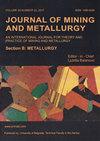熔盐电解纯镍渗硼层的表征及生长动力学
IF 1
4区 材料科学
Q3 METALLURGY & METALLURGICAL ENGINEERING
Journal of Mining and Metallurgy Section B-Metallurgy
Pub Date : 2022-01-01
DOI:10.2298/jmmb211101003w
引用次数: 0
摘要
采用熔盐电解法用Na2B4O7?报道了以10H2O-Na2CO3为电解液,硼化层的表征和生长动力学。实验在碳化硅坩埚中进行,温度分别为1193 K、1223 K和1243 K,温度分别为1、2、3和4 h。采用扫描电子显微镜(SEM)、x射线能谱仪(EDS)和x射线衍射仪(XRD)对纯镍表面形貌和相形成进行了分析。采用显微硬度计和电化学工作站分别测试渗硼试样的表面硬度和耐蚀性。渗硼层由硼化镍组成,厚度为71 ~ 184 μ m。渗硼1 h后,富硅硼化物的硬度为966 HK,略低于镍硼化物的硬度(992-1008 HK);电解4 h后,表面硬度达到1755 HK。电化学阻抗谱分析表明,渗硼样品的耐蚀性优于纯镍样品。用数学方法分析了渗硼层厚度与时间的关系,研究了渗硼层的生长动力学。然后分别计算了硼原子在1193 K、1223 K和1243 K时在镍中的扩散系数常数,得到了硼原子在镍中渗硼层厚度的估算公式。本文章由计算机程序翻译,如有差异,请以英文原文为准。
Characterizations and growth kinetics of the borided layer formed on pure nickel by molten salt electrolysis
Molten salt electrolysis was applied for the boronizing of nickel with Na2B4O7?10H2O-Na2CO3 as the electrolyte and characterizations and the growth kinetics of borided layer is reported. The experiment was carried out in silicon carbide crucible at 1193 K, 1223 K and 1243 K for 1 h, 2 h, 3 h and 4 h. The morphology and phases formed on the surface of pure nickel were analyzed by means of scanning electron microscopy (SEM), energy dispersive X-ray spectroscopy (EDS) and X-ray diffraction analysis (XRD). The surface hardness and corrosion resistance of the boronized sample were tested by micro hardness tester and electrochemical workstation respectively. The borided layer was composed of nickel borides and its thickness ranged from 71 to 184 ?m. After 1 h boronizing, the hardness of the silicon rich borides is 966 HK, which is a little lower than that of the nickel borides (992-1008 HK); the surface hardness reached 1755 HK after 4 h electrolysis. Electrochemical impedance spectroscopy analysis showed that the corrosion resistance of boronized sample is better than that of pure nickel. Borided layer growth kinetics was studied by analyzing the relationship between thickness of the borided layer and time by mathematical method. Then the diffusion coefficient constant of boron atom in nickel at 1193 K, 1223 K and 1243 K was calculated accordingly and an equation was obtained to estimate the thickness of the borided layer.
求助全文
通过发布文献求助,成功后即可免费获取论文全文。
去求助
来源期刊
CiteScore
2.00
自引率
40.00%
发文量
19
审稿时长
2 months
期刊介绍:
University of Belgrade, Technical Faculty in Bor, has been publishing the journal called Journal of Mining and Metallurgy since 1965 and in 1997 it was divided in two independent journals dealing with mining and metallurgy separately. Since 2009 Journal of Mining and Metallurgy, Section B: Metallurgy has been accepted in Science Citation Index Expanded.
Journal of Mining and Metallurgy, Section B: Metallurgy presents an international medium for the publication of contributions on original research which reflect the new progresses in theory and practice of metallurgy. The Journal covers the latest research in all aspects of metallurgy including hydrometallurgy, pyrometallurgy, electrometallurgy, transport phenomena, process control, solidification, mechanical working, solid state reactions, materials processing, surface treatment and relationships among processing, structure, and properties of materials.

 求助内容:
求助内容: 应助结果提醒方式:
应助结果提醒方式:


